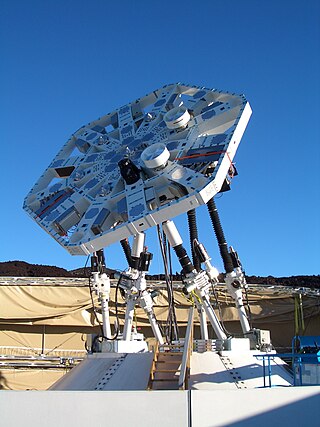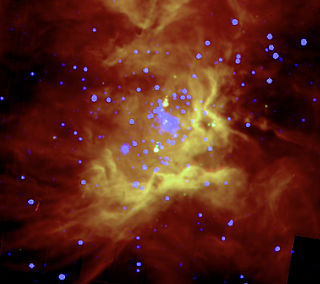
The Virgo Cluster is a large cluster of galaxies whose center is 53.8 ± 0.3 Mly away in the constellation Virgo. Comprising approximately 1,300 member galaxies, the cluster forms the heart of the larger Virgo Supercluster, of which the Local Group is a member. The Local Group actually experiences the mass of the Virgo Supercluster as the Virgocentric flow. It is estimated that the Virgo Cluster's mass is 1.2×1015M☉ out to 8 degrees of the cluster's center or a radius of about 2.2 Mpc.

Messier 87 is a supergiant elliptical galaxy in the constellation Virgo that contains several trillion stars. One of the largest and most massive galaxies in the local universe, it has a large population of globular clusters—about 15,000 compared with the 150–200 orbiting the Milky Way—and a jet of energetic plasma that originates at the core and extends at least 1,500 parsecs, traveling at a relativistic speed. It is one of the brightest radio sources in the sky and a popular target for both amateur and professional astronomers.

A proplyd, short for ionized protoplanetary disk, is an externally illuminated photoevaporating protoplanetary disk around a young star. Nearly 180 proplyds have been discovered in the Orion Nebula. Images of proplyds in other star-forming regions are rare, while Orion is the only region with a large known sample due to its relative proximity to Earth.

3C 279 is an optically violent variable quasar (OVV), which is known in the astronomical community for its variations in the visible, radio and x-ray bands. The quasar was observed to have undergone a period of extreme activity from 1987 until 1991. The Rosemary Hill Observatory (RHO) started observing 3C 279 in 1971, the object was further observed by the Compton Gamma Ray Observatory in 1991, when it was unexpectedly discovered to be one of the brightest gamma ray objects in the sky. It is also one of the brightest and most variable sources in the gamma ray sky monitored by the Fermi Gamma-ray Space Telescope. It was used as a calibrator source for Event Horizon Telescope observations of M87* that resulted in the first image of a black hole.

A rogueplanet, also termed a free-floating planet (FFP) or an isolated planetary-mass object (iPMO), is an interstellar object of planetary mass which is not gravitationally bound to any star or brown dwarf.

Gliese 436 is a red dwarf located 31.9 light-years away in the zodiac constellation of Leo. It has an apparent visual magnitude of 10.67, which is much too faint to be seen with the naked eye. However, it can be viewed with even a modest telescope of 2.4 in (6 cm) aperture. In 2004, the existence of an extrasolar planet, Gliese 436 b, was verified as orbiting the star. This planet was later discovered to transit its host star.
Antarctic Submillimeter Telescope and Remote Observatory, or AST/RO, was a 1.7 meter diameter off-axis telescope for research in astronomy and aeronomy at wavelengths between 0.2 and 2 mm. The instrument operated between 1994 and 2005 at the South Pole with four heterodyne receivers and three acousto-optical spectrometers. It was replaced by the 10-m South Pole Telescope.
In astronomy, the intracluster medium (ICM) is the superheated plasma that permeates a galaxy cluster. The gas consists mainly of ionized hydrogen and helium and accounts for most of the baryonic material in galaxy clusters. The ICM is heated to temperatures on the order of 10 to 100 megakelvins, emitting strong X-ray radiation.
Paul Boltwood was a Canadian amateur astronomer. He was engaged in developing hardware and software for deep sky imaging and in research of brightness variations in active galactic nuclei. He was also acknowledged for his studies of near-nucleus activity in Comet Hyakutake.

The Yuan-Tseh Lee Array for Microwave Background Anisotropy, also known as the Array for Microwave Background Anisotropy (AMiBA), is a radio telescope designed to observe the cosmic microwave background and the Sunyaev-Zel'dovich effect in clusters of galaxies.

3C 286, also known by its position as 1328+307 or 1331+305, is a quasar at redshift 0.8493 with a radial velocity of 164,137 km/s. It is part of the Third Cambridge Catalogue of Radio Sources.
HAT-P-17 is a K-type main-sequence star about 92.6 parsecs (302 ly) away. It has a mass of about 0.857 ± 0.039 M☉. It is the host of two planets, HAT-P-17b and HAT-P-17c, both discovered in 2010. A search for a binary companion star using adaptive optics at the MMT Observatory was negative. A candidate companion was detected by a spectroscopic search of high-resolution K band infrared spectra taken at the Keck observatory.
The Event Horizon Telescope (EHT) is a large telescope array consisting of a global network of radio telescopes. The EHT project combines data from several very-long-baseline interferometry (VLBI) stations around Earth, which form a combined array with an angular resolution sufficient to observe objects the size of a supermassive black hole's event horizon. The project's observational targets include the two black holes with the largest angular diameter as observed from Earth: the black hole at the center of the supergiant elliptical galaxy Messier 87, and Sagittarius A* at the center of the Milky Way.
Kepler-43, formerly known as KOI-135, is a star in the northern constellation of Cygnus. It is located at the celestial coordinates: Right Ascension 19h 00m 57.8034s, Declination +46° 40′ 05.665″. With an apparent visual magnitude of 13.996, this star is too faint to be seen with the naked eye. The Kepler-43 has a very strong starspot activity.

RCW 36 is an emission nebula containing an open cluster in the constellation Vela. This H II region is part of a larger-scale star-forming complex known as the Vela Molecular Ridge (VMR), a collection of molecular clouds in the Milky Way that contain multiple sites of ongoing star-formation activity. The VMR is made up of several distinct clouds, and RCW 36 is embedded in the VMR Cloud C.
SN 2013ej is a Type II-P supernova in the nearby spiral galaxy Messier 74. It was discovered by the Lick Observatory Supernova Search on July 25, 2013, with the 0.76 m Katzman Automatic Imaging Telescope, with pre-discovery images having been taken the day before.
The small planet radius gap is an observed scarcity of planets with radii between 1.5 and 2 times Earth's radius, likely due to photoevaporation-driven mass loss. A bimodality in the Kepler exoplanet population was first observed in 2011 and attributed to the absence of significant gas atmospheres on close-in, low-mass planets. This feature was noted as possibly confirming an emerging hypothesis that photoevaporation could drive atmospheric mass loss This would lead to a population of bare, rocky cores with smaller radii at small separations from their parent stars, and planets with thick hydrogen- and helium-dominated envelopes with larger radii at larger separations. The bimodality in the distribution was confirmed with higher-precision data in the California-Kepler Survey in 2017, which was shown to match the predictions of the photoevaporative mass-loss hypothesis later that year.

Ramesh Narayan is an Indian-American theoretical astrophysicist, currently the Thomas Dudley Cabot Professor of the Natural Sciences in the Department of Astronomy at Harvard University. Full member of the National Academy of Sciences, Ramesh Narayan is widely known for his contributions on the theory of black hole accretion processes. Recently he is involved in the Event Horizon Telescope project, which led in 2019 to the first image of the event horizon of a black hole.
Monika Mościbrodzka is a Polish astrophysicist who is a professor at Radboud University Nijmegen. She is an expert in general relativistic plasma dynamics and numerical astrophysics. She was part of the Event Horizon Telescope team who contributed to the first direct image of a black hole, supermassive black hole M87*. She was awarded the 2022 Dutch Research Council Athena Prize and the 2023 Eddington Medal of the Royal Astronomical Society.











